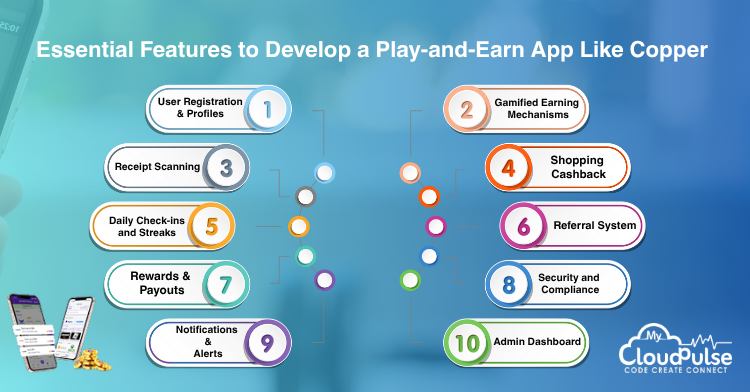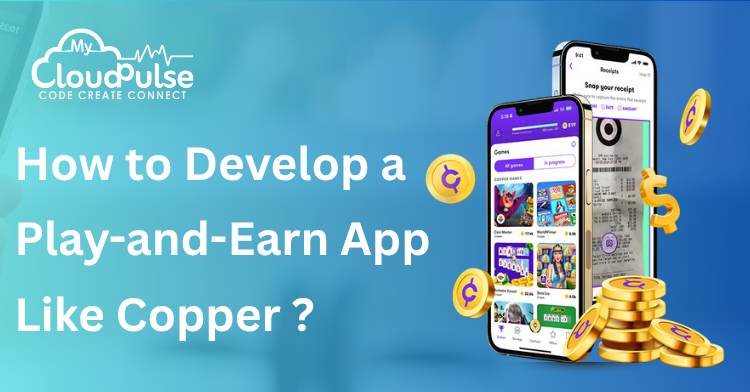In today’s digitally driven world, the fusion of gaming and earning has created a compelling ecosystem of user engagement and monetization. Develop a Play-and-earn app like Copper have emerged as a revolutionary trend, allowing users to turn their time and attention into tangible rewards. One of the standout players in this space is Copper, a popular app that enables users to earn by playing games, taking surveys, shopping online, scanning receipts, and more.
Unlike traditional gaming or survey apps, Copper gamifies everyday activities and turns them into rewarding opportunities. Whether it’s watching a quick video, completing a small task, or linking a bank card for cashback, the app creates a low-barrier gateway to earning small amounts of money frequently.
This comprehensive guide will walk you through every aspect involved to Develop a Play-and-Earn App Like Copper – from exploring app features, monetization strategies, and development stages to estimating costs and organizing a capable team. If you’re an entrepreneur, product manager, or investor exploring the play-and-earn app space, this is your starting blueprint.
App Stats
Understanding the key metrics and statistics of Copper gives a benchmark for success and provides insight into what works in this domain.
- Downloads: With over 1 million downloads on Android and a strong presence on iOS, Copper demonstrates significant market penetration in the United States and growing interest globally.
- User Rating: 4.8/5 on the App Store and 4.4/5 on Google Play reflects user satisfaction, app reliability, and successful delivery of value.
- User Base: Copper boasts more than 4 million users who are actively engaging with its earning mechanisms.
- Ranking: It consistently ranks within the top 100 apps in the Finance and Lifestyle categories across both platforms.
- Redemption Model: Users earn “Creds” and can cash out once they accumulate 500 credits, which is equivalent to $5. Payouts are processed via PayPal, Venmo, or gift cards.
- Engagement: High daily active user (DAU) rate due to features like daily check-ins, streak bonuses, and personalized task recommendations.
These stats highlight the importance of a diversified earning structure, simple reward mechanisms, and intuitive UX to keep users engaged and retained.
Essential Features to Develop a Play-and-Earn App Like Copper
To replicate Copper’s success, your app must offer rich functionality, intuitive design, and a seamless earning experience. Let’s look at each feature in depth:

1. User Registration & Profiles
Users can sign up using email, phone numbers, or social login options. Profiles may include user preferences, earning history, linked payment methods, and completion rates for activities. Age verification and KYC might be necessary for financial compliance.
2. Gamified Earning Mechanisms
- Games: Users earn points by playing in-app or third-party mini-games.
- Surveys: Integration with survey partners lets users answer quick questions for rewards.
- Offers: Complete app installations, sign-ups, or subscriptions.
- Video Ads: Watch short advertisements to earn instant rewards.
3. Receipt Scanning
Users upload retail receipts using their phone camera. OCR (Optical Character Recognition) technology extracts details, validates purchase info, and rewards based on eligible items or stores.
4. Shopping Cashback
By securely linking a debit/credit card, users automatically earn cashback when they shop at participating retailers. The app tracks purchases in real-time using secure transaction data.
5. Daily Check-ins and Streaks
Encourages habitual app usage by rewarding users for logging in daily. Extended streaks result in bonus credits, making it a critical user retention feature.
6. Referral System
Users can invite friends using a unique referral code. Both parties earn when the invitee performs qualifying actions. Tiered systems can boost viral growth.
7. Rewards & Payouts
Credits earned are redeemable via popular gift cards or direct cashout platforms like PayPal. Donation options can be added for users who want to support charities.
8. Security and Compliance
Ensure encryption protocols for secure data handling. Compliance with PCI-DSS, GDPR, and local financial laws is a must when dealing with user financial data.
9. Notifications & Alerts
Push notifications inform users of new tasks, low balance alerts, payout updates, and personalized earning opportunities.
10. Admin Dashboard
Admins can manage user activity, track offer performance, manage advertisers, flag suspicious behavior, and analyze usage trends.
Monetization Models
Revenue generation is a central component of your app’s business model. Below are the tried-and-true models used by Copper and other similar apps:
1. Affiliate Marketing
The app integrates offers and surveys through affiliate networks and earns a commission every time a user completes an action like installing an app, subscribing to a service, or buying a product.
2. Ad Revenue
Using rewarded video ads, banner ads, and interstitials, the app earns per impression, click, or completed view. AdMob, Unity Ads, and IronSource are popular partners.
3. In-App Purchases
Users may choose to purchase premium plans for ad-free experiences, faster payouts, or exclusive offers. Optional boosters can also be sold.
4. Cashback Partnerships
When users shop using linked cards at participating stores, the app earns a percentage of the sale from the retailer and shares part of it with users.
5. Data Licensing (Ethical)
With explicit user consent, behavioral insights and anonymized data may be shared with market research firms.
6. Subscription Model
Recurring monthly or yearly payments can unlock advanced features such as higher reward rates, priority customer support, or access to exclusive earning categories.
Process to Develop a Play-and-Earn App Like Copper
The journey from idea to launch follows these critical stages:
1. Market Research & Validation
Begin by studying target demographics, competitor offerings, and market gaps. Identify what motivates users to use apps like Copper and how you can differentiate.
2. Requirement Analysis & Planning
Detail every feature, flow, and integration. Map user journeys. Choose your target platforms (iOS, Android, or both).
3. UI/UX Design
Design an intuitive, visually appealing interface. Create wireframes, prototypes, and user flows. Gamification elements should be embedded within the interface design.
4. Front-End Development
Use cross-platform tools like Flutter or React Native for rapid deployment. Ensure smooth animations, fast loading times, and responsive layouts.
5. Back-End Development
Build robust APIs and backend systems to handle user accounts, transaction histories, credit logs, offer status, and analytics. Use Node.js or Python frameworks.
6. Third-Party Integrations
Set up APIs for:
- Surveys and Offers (TheoremReach, Pollfish)
- Ads (AdMob, Tapjoy)
- Payments (Stripe, PayPal, Venmo)
- OCR (for receipt scanning)
7. Security Implementation
Encrypt all sensitive data, use secure payment gateways, and include 2FA for user login. Fraud detection algorithms and bot prevention mechanisms are crucial.
8. Testing & QA
Thorough testing is required to avoid bugs and ensure smooth functionality. Include unit testing, load testing, security audits, and user acceptance testing.
9. Launch & Marketing
Soft launch to gather user feedback. Optimize app store listings (ASO). Launch influencer campaigns, run paid ads, and offer launch promotions.
10. Post-Launch Support
Continue refining the product based on feedback. Add new features, optimize rewards, and maintain server infrastructure. Track KPIs and app analytics for decision-making.
Cost to Develop a Play-and-Earn App Like Copper
The total cost will vary depending on the feature complexity, location of the development team, and timeline. Below is a detailed cost breakdown:
| Component | Estimated Cost (USD) |
| Market Research | $2,000 – $5,000 |
| UI/UX Design | $5,000 – $10,000 |
| Front-End Development | $10,000 – $20,000 |
| Back-End Development | $15,000 – $30,000 |
| Third-Party APIs & Licenses | $5,000 – $10,000 |
| Testing & QA | $5,000 – $10,000 |
| Marketing & Launch | $5,000 – $15,000 |
| Total | $50,000 – $100,000 |
Note: Post-launch maintenance and customer support may require an additional $1,000 to $5,000/month.
Team Structure
To build a scalable and sustainable play-and-earn app like Copper, you’ll need a team with cross-functional expertise:
1. Product Manager
Coordinates overall development, prioritizes features, and aligns product vision with business goals.
2. UI/UX Designer
Designs user flows, visual interfaces, gamification elements, and ensures a delightful user experience.
3. Front-End Developers
Code the user-facing part of the app using cross-platform frameworks for performance and scalability.
4. Back-End Developers
Create and maintain server logic, databases, and APIs required for all app functions.
5. Mobile App Developers
Fine-tune performance and user experience for both Android and iOS platforms.
6. QA Engineers
Run various testing protocols to detect and fix bugs and ensure security compliance.
7. Marketing Specialist
Manages outreach, app store marketing, influencer partnerships, and user acquisition strategies.
8. Support & Community Manager
Provides assistance to users, moderates communities, and collects valuable feedback for the product team.
Conclusion
Copper has set a gold standard in the play-and-earn ecosystem by combining usability, variety, and meaningful rewards. Its success illustrates the vast potential of microtask-based income models when paired with engaging UX and strong monetization.
To develop a similar app, you’ll need more than a solid tech team—you need insight into user behavior, ethical monetization practices, and a roadmap for scaling. By offering a clean design, diverse earning avenues, timely rewards, and strong security, your app can carve out a niche in this booming sector.
FAQs
Yes, as long as the app does not promote gambling or deceptive practices and adheres to data privacy laws like GDPR and CCPA.
Copper earns through affiliate commissions, ad revenues, merchant partnerships, and data analytics (with user consent).
Yes, but localization of language, rewards, compliance, and currency is essential for successful adoption.
Main challenges include real-time payout processing, user retention, fraud prevention, and managing API-based partnerships.
An MVP can take 4-6 months to build. A full-featured application may take 8-12 months, depending on complexity and team size.



